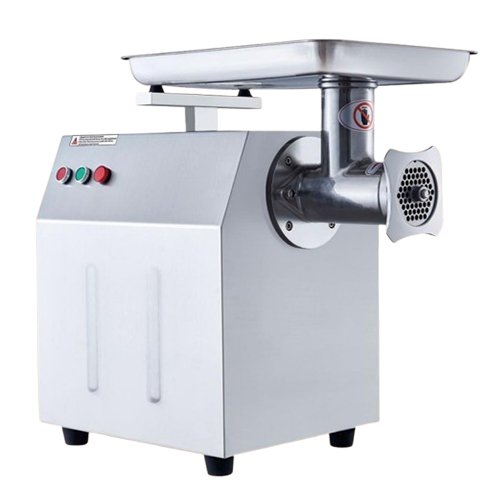
Fresh ground meat represents the foundation of countless culinary applications, from gourmet burgers and artisanal sausages to specialty meatballs and custom blends. However, relying on pre-ground meat from suppliers often means compromising on freshness, quality control, and cost efficiency. Manual grinding methods are labor-intensive, time-consuming, and inconsistent, making them impractical for commercial operations that demand high-volume production and consistent results. For restaurants, butcher shops, food processors, and institutional kitchens, the ability to grind fresh meat on-demand provides superior quality control, cost savings, and menu flexibility. A commercial electric meat grinder transforms this essential process into an efficient, controlled operation that maintains the highest standards of freshness, safety, and consistency while dramatically increasing production capacity.
What is a Commercial Meat Grinder?
A commercial meat grinder, also known as a meat mincer, is a powerful electric machine designed to break down large cuts of meat into smaller, uniform pieces through a mechanical grinding process. These machines feature a robust motor that drives an auger system, which feeds meat through a grinding chamber where it’s forced through perforated plates with holes of varying sizes to achieve the desired grind consistency. Commercial units are built with heavy-duty components, including stainless steel construction, powerful motors, and precision-engineered grinding mechanisms that can handle continuous operation under demanding conditions. The grinding process maintains meat temperature and texture while ensuring consistent particle size, which is crucial for food safety, cooking performance, and final product quality. Advanced commercial grinders often include multiple grinding plates, safety features, and easy-cleaning designs that meet stringent commercial food service requirements.
Where Can Electric Meat Grinders Be Used?
The versatility and efficiency of commercial electric meat grinders make them indispensable across numerous professional food service environments where fresh ground meat is essential for operations.
Restaurants and Commercial Kitchens: High-volume restaurants use commercial grinders to create custom meat blends, ensure freshness, and maintain control over fat content and seasoning for signature dishes like burgers, meatballs, and specialty preparations.
Butcher Shops and Meat Markets: Traditional butcher shops rely on heavy-duty grinders for custom grinding services, creating specific blends for customers, and processing large quantities of fresh ground meat for retail sales.
Food Processing and Manufacturing Facilities: Large-scale processors utilize industrial-grade grinders as integral components of their production lines, processing substantial volumes for wholesale distribution and packaged products.
Institutional Kitchens: Schools, hospitals, and corporate cafeterias use commercial grinders to process large quantities of ground meat efficiently while maintaining cost control and quality standards.
Specialty Food Producers: Artisanal sausage makers, specialty meat processors, and gourmet food producers depend on precision grinders to create unique products and maintain consistent quality across batches.
Catering and Food Service Operations: Large catering companies utilize commercial grinders to prepare fresh ground meat for events, ensuring quality and enabling custom preparations for diverse menu requirements.
Delis and Sandwich Shops: Establishments specializing in fresh sandwiches and prepared foods use grinders to create custom meat preparations and maintain ingredient freshness.
Why Should You Choose a Commercial Meat Grinder?
Investing in a quality commercial electric meat grinder delivers substantial operational advantages that directly impact food quality, cost efficiency, and production capabilities.
Superior Freshness and Quality Control: Grinding meat on-demand ensures maximum freshness and allows complete control over ingredients, fat content, and seasoning, resulting in superior taste and texture compared to pre-ground alternatives.
Significant Cost Savings: Purchasing whole cuts and grinding in-house typically costs substantially less than buying pre-ground meat, with savings often justifying equipment investment within months of operation.
Enhanced Food Safety: Fresh grinding reduces the risk of contamination associated with pre-ground meat, while proper temperature control during grinding helps maintain food safety standards throughout the process.
Unlimited Menu Flexibility: The ability to create custom blends, adjust fat ratios, and combine different cuts enables unlimited menu creativity and the development of signature items that differentiate your operation.
Consistent Portion Control: Commercial grinders provide precise control over grind size and consistency, ensuring uniform cooking results and predictable portion yields that support accurate costing and inventory management.
Increased Production Efficiency: High-capacity commercial grinders can process substantial quantities quickly, enabling operations to meet peak demand periods while maintaining consistent quality standards.
Reduced Waste and Better Utilization: Grinding trim pieces and less popular cuts into ground meat reduces waste and maximizes the value extracted from meat purchases.
How Do You Properly Operate an Electric Meat Mincer?
Safe and effective operation requires strict adherence to established procedures and comprehensive understanding of the equipment’s capabilities and safety requirements.
Pre-Operation Preparation: Before grinding, ensure all equipment components are properly assembled, clean, and at appropriate temperatures. Meat should be well-chilled but not frozen, typically between 32-38°F, to maintain proper texture and prevent bacterial growth.
Proper Meat Preparation: Cut meat into strips or chunks that fit easily into the grinder’s feed tube. Remove any bones, cartilage, or foreign materials that could damage the grinding mechanism or create safety hazards.
Safe Loading Techniques: Use the provided pusher tool to feed meat into the grinder, never using hands or utensils that could contact moving parts. Maintain steady, consistent feeding to ensure optimal grinding performance and prevent motor strain.
Temperature Management: Monitor meat temperature throughout the grinding process, as friction can generate heat that affects quality and safety. If meat becomes warm, pause operation and re-chill before continuing.
Grinding Plate Selection: Choose appropriate grinding plates based on desired final texture, starting with coarser plates for initial grinding and progressing to finer plates for subsequent passes if needed.
Continuous Monitoring: Stay attentive during operation to ensure proper grinding action, watching for signs of clogging, unusual sounds, or inconsistent output that might indicate problems requiring attention.
Thorough Cleaning Protocol: After each use, completely disassemble and clean all components according to food safety guidelines, paying special attention to grinding plates and areas where meat particles might accumulate.
What Should You Consider When Selecting a Commercial Meat Grinder?
Choosing the appropriate commercial meat grinder requires careful evaluation of multiple factors to ensure the equipment matches your specific operational requirements and safety standards.
Motor Power and Capacity: Select a grinder with adequate motor power to handle your typical volume requirements without strain. Heavy-duty operations require robust motors that can maintain consistent performance during continuous use.
Grinding Plate Options and Versatility: Evaluate the variety and availability of grinding plates for different applications. Multiple plate sizes enable versatility in creating various textures and meeting diverse menu requirements.
Construction Quality and Durability: Look for machines built with high-grade stainless steel components that can withstand demanding commercial use while maintaining sanitary standards and resisting corrosion.
Safety Features and Compliance: Prioritize grinders with comprehensive safety systems, including proper guards, emergency stops, and safety switches that meet industry standards and protect operators during use.
Ease of Cleaning and Maintenance: Consider how easily the machine disassembles for thorough cleaning and sanitization. Equipment that facilitates proper hygiene practices is essential for food safety compliance.
Processing Speed and Efficiency: Evaluate the machine’s grinding speed and efficiency to ensure it can meet your peak production demands without compromising quality or creating bottlenecks in your operation.
Size and Workspace Requirements: Consider your available space and ensure the grinder fits comfortably in your workspace while providing adequate clearance for safe operation and maintenance access.
Manufacturer Support and Service: Choose equipment from manufacturers that provide reliable technical support, readily available replacement parts, and comprehensive service networks to minimize downtime.
Commercial electric meat grinders represent a critical investment in food quality, operational efficiency, and cost control for any establishment that regularly uses ground meat. Their ability to deliver superior freshness, consistency, and cost savings while providing unlimited menu flexibility makes them essential for competitive food service operations. The combination of enhanced quality control, reduced costs, and increased production capacity creates compelling value for businesses of all sizes.
Elevate your meat processing capabilities today. Browse our selection of professional-grade commercial meat grinders designed for demanding food service applications, or connect with our meat processing equipment specialists to discuss your specific grinding requirements and find the perfect solution for your operation.

